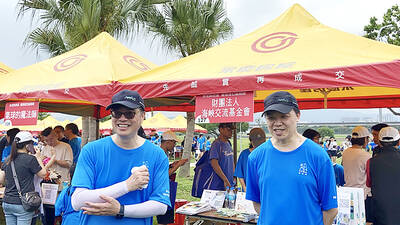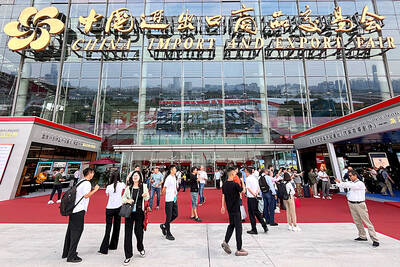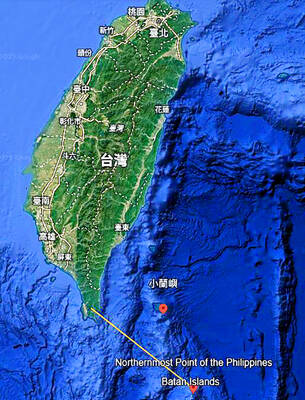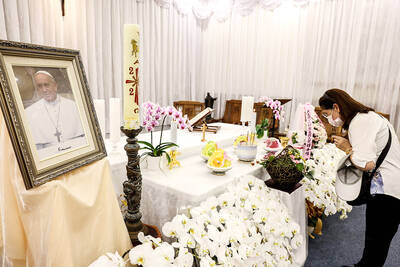The Ministry of National Defense on Monday denied reports that the armoring on the domestically produced CM-32 Clouded Leopard personnel carrier, which entered mass production in late 2010, was below standard.
The Chinese-language Apple Daily said ballistic resistance live-fire tests in March 2010 showed that the armor plating on the Clouded Leopard does not comply with the bulletproof specifications set by the military. Puncture holes were observed on an armored panel at the rear of one of the vehicles, it said, adding that this raised questions about the armor’s ability to protect personnel on board.
The eight-wheeled, 25-tonne Clouded Leopard armored vehicle is a joint project between the Ordnance Readiness Development Center and the Chungshan Institute of Science and Technology (中山科學研究院).

Photo: Chan Chao-yang, Taipei Times
In a press release on Monday, the ministry denied that the armor plating, which is also domestically produced, was not up to standards and said the armoring, which had been tested several times, complied with specifications.
The front plating of the vehicle is designed to withstand 12.7mm machine gun and armor-piercing incendiary (API) ammunition, while the side and rear sections provide protection against 7.62mm ammunition and small arms fire.
Commenting on photographs showing holes in the rear of the vehicle following the ballistic test, the military said a 12.7mm API round missed the targeted front arc plate and, as the engine hatch plate was not installed during the test, the round passed through the engine compartment and penetrated the rear plate instead. It added that since the damaged rear plate was not designed to resist a 12.7mm round, the result was invalid.
It is important to distinguish between the armor requirements for the front of the vehicle and those for the side and rear, it said.
The armoring complies with the operational needs set by the army, it said, adding that if necessary, ceramic armor could be added to increase protection.
However, some military analysts have said that questions remain over the results of subsequent tests and how the engine hatch plate would perform against 12.7mm API.
Initiated in 2005, production of the CM-32 faced a number of problems during development and at one point came close to being shut down amid controversy over procurement, a budget freeze and the vehicle’s failure during a demonstration in January 2005 to ascend a 70-degree slope. Later on, chassis cracks in several of the initial 14 vehicles also threatened further delays, though the Armaments Bureau in May last year said the problem had been fixed and the program remained on schedule.
Mass production, initially scheduled for 2007, began in November 2010, with the army set to procure 650 CM-32s for NT$58 billion (US$1.8 billion) to replace ageing M113s and V-150 armored vehicles.
With translation by Stacy Hsu, Staff Writer

SECURITY: As China is ‘reshaping’ Hong Kong’s population, Taiwan must raise the eligibility threshold for applications from Hong Kongers, Chiu Chui-cheng said When Hong Kong and Macau citizens apply for residency in Taiwan, it would be under a new category that includes a “national security observation period,” Mainland Affairs Council (MAC) Minister Chiu Chui-cheng (邱垂正) said yesterday. President William Lai (賴清德) on March 13 announced 17 strategies to counter China’s aggression toward Taiwan, including incorporating national security considerations into the review process for residency applications from Hong Kong and Macau citizens. The situation in Hong Kong is constantly changing, Chiu said to media yesterday on the sidelines of the Taipei Technology Run hosted by the Taipei Neihu Technology Park Development Association. With

CARROT AND STICK: While unrelenting in its military threats, China attracted nearly 40,000 Taiwanese to over 400 business events last year Nearly 40,000 Taiwanese last year joined industry events in China, such as conferences and trade fairs, supported by the Chinese government, a study showed yesterday, as Beijing ramps up a charm offensive toward Taipei alongside military pressure. China has long taken a carrot-and-stick approach to Taiwan, threatening it with the prospect of military action while reaching out to those it believes are amenable to Beijing’s point of view. Taiwanese security officials are wary of what they see as Beijing’s influence campaigns to sway public opinion after Taipei and Beijing gradually resumed travel links halted by the COVID-19 pandemic, but the scale of

A US Marine Corps regiment equipped with Naval Strike Missiles (NSM) is set to participate in the upcoming Balikatan 25 exercise in the Luzon Strait, marking the system’s first-ever deployment in the Philippines. US and Philippine officials have separately confirmed that the Navy Marine Expeditionary Ship Interdiction System (NMESIS) — the mobile launch platform for the Naval Strike Missile — would take part in the joint exercise. The missiles are being deployed to “a strategic first island chain chokepoint” in the waters between Taiwan proper and the Philippines, US-based Naval News reported. “The Luzon Strait and Bashi Channel represent a critical access

Pope Francis is be laid to rest on Saturday after lying in state for three days in St Peter’s Basilica, where the faithful are expected to flock to pay their respects to history’s first Latin American pontiff. The cardinals met yesterday in the Vatican’s synod hall to chart the next steps before a conclave begins to choose Francis’ successor, as condolences poured in from around the world. According to current norms, the conclave must begin between May 5 and 10. The cardinals set the funeral for Saturday at 10am in St Peter’s Square, to be celebrated by the dean of the College